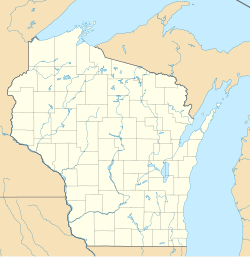Kiel Mill
The Kiel Mill is a historic grinding and feed mill located in Kiel, Wisconsin. It was added to the Wisconsin State Register of Historic Places in 2021[1], and the National Register of Historic Places in 2022.[2]
Kiel Mill | |
 Kiel Mill | |
| Location | 11 Fremont St, Kiel, Wisconsin |
|---|---|
| Coordinates | 43°54′45″N 88°01′37″W / 43.91244°N 88.02690°W |
| Built | 1883 |
| Architect | Carl Koeser |
| NRHP reference No. | 100007129[3] |
| Added to NRHP | February 4, 2022 |
History
[edit]The mill was built by German-born William Meyer in 1883 on property he owned along the Sheboygan River. It was the city's first and only water-powered flour mill. By 1893, the mill transitioned from flour milling to grinding feed for livestock. In 1894, a powerhouse was built to accommodate steam power. The new wing suffered a fire in 1897 but was quickly rebuilt.[1]
Meyer sold the mill to the Kiel Grain and Milling Company in 1901. A brick chimney was added in 1902.[2] Harry and Walter Klemme purchased the mill in 1919 and 1920, respectively, and owned it until 1953, during which time it was converted to electrical power and a warehouse was added.[1]
Modern use
[edit]After milling operations ceased in 1981, the building housed a Salvation Army location and a woodworking shop. Other attempts to restore the mill for commercial use failed, and the building stood vacant for 20 years. As of 2020[update], the Kiel Mill is under restoration, with a portion of the property anticipated for mixed-use residential.[2]
References
[edit]- ^ a b c "Kiel Mill Listed on the State Register of Historic Places". Wisconsin Historical Society. 2021-04-08. Retrieved 2025-08-02.
- ^ a b c "11 E Fremont St | National or State Registers Record". Wisconsin Historical Society. 2012-01-01. Retrieved 2025-08-02.
- ^ "National Register Information System". National Register of Historic Places. National Park Service. July 9, 2010.
- Buildings and structures in Manitowoc County, Wisconsin
- National Register of Historic Places in Manitowoc County, Wisconsin
- Buildings and structures completed in 1883
- 1880s architecture in the United States
- Flour mills in the United States
- Grinding mills on the National Register of Historic Places in Wisconsin
- 1883 establishments in Wisconsin
- 1981 disestablishments in Wisconsin

